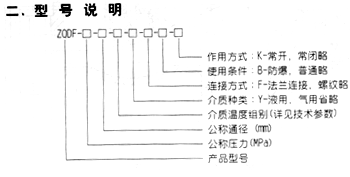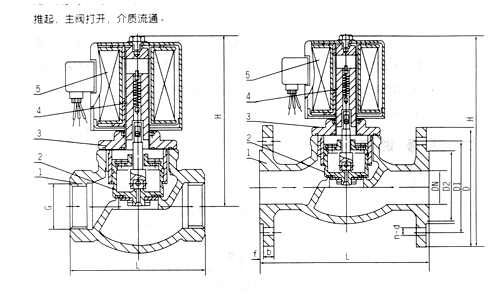Instructions for stainless steel steam solenoid valve 1. Steam solenoid valve product use
Flange is a method of connecting pipes valves, pumps and other equipment to form a piping system.Application: oil,
chemical industry, water conservancy,electric power, boiler, machinery, metallurgy,sanitary, construction etc.
A blind flange is a round plate which has all of the relevant blowholes except center hole, and because of this feature the blind flange is usually used to close off the ends of a piping systems and pressure vessel openings. It also permits easy access to the interior of a line or vessel once it has been sealed and must be reopened.
hut off at the nearest valve, which could be miles away from the repair area. Valves are also very expensive and are prone to sticking. The blind flange is a much more cost efficient way of sealing a pipe.
Flanges Types
Slip On Flange ,Welding Neck Flange ,blind flange ,plate flange ,socket welding flange ,
long welding neck flange ,orifice flange ,loose plate flange
Materials
carbon steel :ASTM A105 ,A694.A36,Rst37.2,C22.8,SA350 LF2/LF1,Q235,Q345,etc
stainless steel :304,304L,316,316L,A182,etc
alloy steel :ASTMA182,F11,F12,F60,F22,etc
Marking type
forged or forging
Standard
ANSI B16.5/B16.47/B16.48/B16.36,ASME ,MSS SP44,API ,AWWA
DIN2527,DIN2566,DIN2573,DIN2576,DIN2641,DIN2642,DIN2655,DIN2627,DIN2628,DIN2631,DIN2632,DIN2633
DIN2634,DIN2635,DIN2636,DIN2637,DIN2638,DIN2673
BS4504/10
Pressure grade
ANSI B16.5 B150Lbs, 300Lbs, 600Lbs, 900Lbs, 1500Lbs, 2500Lbs
BS4504:PN2.5,PN6,PN10,PN16,PN20,PN25,PN40,PN63,PN100,PN160
JIS:5K,10K,16K,20K,30K,40k,63k
Facing
RF/M/FM/G/T/RJ
ZQDF steam solenoid valve is an actuator for industrial process automation control system. It can automatically open or close the valve after receiving the electronic control signal to realize the on-off or flow regulation control of the fluid medium in the pipeline, thus the temperature in the system, Parameters such as flow rate and pressure are automatically adjusted or remotely controlled.
Second, steam solenoid valve model description 
Niwei solenoid valve products can be widely used in textile, printing and dyeing, chemical, plastic, rubber, pharmaceutical, food, building materials, "target=_blank> building materials, machinery, electrical appliances, surface treatment and other production and scientific research departments as well as bathrooms, canteens, air conditioners, etc. In daily life facilities, ZQDF steam solenoid valve is mainly used for the control of air, steam, gas and other gaseous media; ZQDF-Y series is mainly used for liquid medium such as tap water, distilled water, frozen brine, electroplating waste liquid, etc. Oil of 4°E.
Third, steam solenoid valve product features
Corrosion resistance: The main components of the valve plug, valve body, etc. are made of stainless steel "target=_blank> stainless steel and cast steel, good corrosion resistance.
Heat resistance: The electromagnetic and sealing parts are all made of special high temperature resistant electrical materials and sealing materials, and effective heat insulation measures are adopted.
Wear-resistance: Reasonable material selection, clever use of fluid lubrication between the valve plug and the valve body to reduce wear.
Resistance to condensation: The cold north water of the steam pipe is an important factor affecting the action of the steam solenoid valve. The valve is not affected by the condensed water.
Fourth, steam solenoid valve structure and principle
The valve is a step-by-step direct pilot type solenoid valve, which can be divided into a normally closed solenoid valve and a normally open solenoid valve according to different opening and closing states when the power is off. Normally closed solenoid valve, after the coil is energized, the armature first lifts the auxiliary valve plug under the action of electromagnetic force, and the fluid on the main valve cup flows away through the auxiliary valve, reducing the pressure acting on the main valve cup, when the main valve When the pressure on the valve cup is reduced to a certain value, the armature drives the main valve cup and uses the pressure difference to open the main valve cup and the medium circulates. After the coil is de-energized, the electromagnetic force disappears and the armature is reset by its own weight. At the same time, depending on the medium pressure, the main and auxiliary valves are tightly closed. Normally open solenoid valve, after the coil is energized, the moving iron core moves down due to the suction force, the auxiliary valve plug is pressed down, the auxiliary valve is closed, the pressure in the main valve valve cup rises, and when the pressure rises to a certain value, the main valve cup The pressure difference between the upper and lower sides is the same. Due to the electromagnetic force, the moving iron core loses under the main valve valve cup, the main valve seat is pressed, and the valve is closed. When the coil is de-energized, the electromagnetic suction force is zero, the auxiliary valve plug and the iron core are lifted up by the spring action, the auxiliary valve is opened, and the fluid on the main valve valve cup flows away through the auxiliary valve, reducing the effect on the main valve valve cup. The pressure, when the pressure on the main valve cup is reduced to a certain value, the main valve cup is pushed up by the pressure difference, the main valve is opened, and the medium is circulated.
Five, steam solenoid valve main technical parameters
model
ZQDF-1
ZQDF-2
ZQDF-3
ZQDF-1Y
ZQDF-2Y
ZQDF-3Y
Nominal pressure MPa
1.6
Working pressure difference MPa
DN15~50
0 to 1.6
DN65~100
0.05~1.6
Media type
Gas, air, etc.
Saturated Vapor
Superheated steam or hot gas
Water oil liquid
Hot water, oil
oil
Medium temperature °C
≤60
≤180
≤220
≤60
≤180
≤220
voltage
Other specifications of AC220V can be used for special order
Service life
According to JB/T7352-94
Leakage m1/min
According to JB/T7352-94·F
Power consumption
AC≤70VA DC≤60W
Explosion-proof mark
dIIBT4
Outlet connector
Internal thread M20×1.5
Ambient temperature
-40~+60°C
Sixth, steam solenoid valve dimensions and connection form 
Nominal diameter
DN
Dimensions
internal thread
Dimensions
Flange connection
H
L
G
H
L
D
D1
D2
b
f
Nd
15
148
92
1/2
176
130
95
65
46
14
2
4-Φ14
20
148
92
3/4
181
150
105
75
56
16
2
4-Φ14
25
148
110
1
210
160
115
85
65
16
3
4-Φ14
32
182
120
11/4
221
180
140
100
76
18
3
4-Φ18
40
182
140
11/2
230
200
150
110
84
18
3
4-Φ18
50
192
162
2
252
230
165
125
99
20
3
4-Φ18
65
265
290
185
145
118
20
3
4-Φ18
80
276
310
200
160
132
20
3
8-Φ18
100
373
350
220
180
156
twenty two
3
8-Φ18
Seven, steam solenoid valve installation instructions
1. When installing, the solenoid valve coil is upward and maintains the vertical position. The arrow or mark on the solenoid valve should be consistent with the flow direction of the pipeline, and should not be installed in places with splashing water or water leakage.
2. The working medium of the solenoid valve should be clean and free of particulate impurities. The dirt and filter on the surface of the solenoid valve internal parts should be cleaned regularly.
3. When the solenoid valve is faulty, in order to isolate the solenoid valve in time and ensure the normal operation of the system, it is better to install a bypass device (Figure 1).
4. In the pipeline system, the diameter of the solenoid valve installed on the branch road should be smaller than the diameter of the main pipeline valve (Figure 2).
5. Before installing the solenoid valve, the pipe must be cleaned. It is recommended to install a filter in front of the valve and a steam pipe to install the trap.
6. The valve cannot be installed in the low recess of the pipeline to prevent the condensation of steam, impurities and the like from being deposited in the valve.
7, the ordinary type can not be used in explosive places.
8. In the case of insufficient rigidity of the pipeline, it is recommended to fix the pipe in front of the valve with a bracket to avoid vibration caused by the solenoid valve working.
9. Before installation, pay attention to see the product label, read the instruction manual carefully, and judge whether the product meets the conditions of use.
10. A pressure gauge should be installed on the pipe before and after the solenoid valve to observe the pipe pressure. 
Eight, steam solenoid valve use and maintenance
1. It is recommended to use a unit to assign someone to take care of the maintenance.
2. After the solenoid valve is installed, it is necessary to pass the medium experiment action several times, and it can be put into formal use after confirming normal.
3. The dirt inside and outside the large valve and the suction surface should be cleaned regularly, taking care not to damage the sealing surface.
4. When the solenoid valve is not used for a long time, the manual valve before the valve should be closed. When re-enabling, the steam solenoid valve should remove the condensed water and make a trial operation several times. It can be put into use after the switch is normal.
5. When the solenoid valve is removed from the pipeline, the internal parts should be wiped clean and stored with compressed air.
6. When the use time is long, if the seal between the piston and the valve seat is not good, the piston sealing surface can be re-polished and then grinded with the valve seat.
7. When working, pay attention to the pressure gauge before and after the valve, the working pressure should not exceed the rated pressure, and the working pressure difference must be within the rated pressure difference. When the working pressure exceeds the rated pressure or the working pressure difference exceeds the rated pressure difference, the solenoid valve should be stopped, and the front and rear manual valves should be closed to prevent the solenoid valve from exploding and leaking.
Thank you for visiting our Niwei Valve website. If there are any valves, we will do our best to provide you with quality service. Niwei Company always adheres to the tenet of "Quality First, Credit First". We will wholeheartedly provide the best service for our customers. We look forward to sincere cooperation and mutual benefit with new and old customers at home and abroad with strong strength. To create a beautiful tomorrow.
Http://news.chinawj.com.cn Editor: (Hardware Business Network Information Center) http://news.chinawj.com.cn
Without the blind flange it would be difficult to perform maintenance or repairs on a pipeline. The flow would need to be s
Blind Flanges are commonly used in petrochemical, pipe engineering, public services and water treatment etc.
Blind Flange,Steel Blind Flange,Forged Blind Flange,Stainless Steel Blind Flange
Shijiazhuang Huize Pipe Fitting Co., Ltd. , https://www.huizegd.com